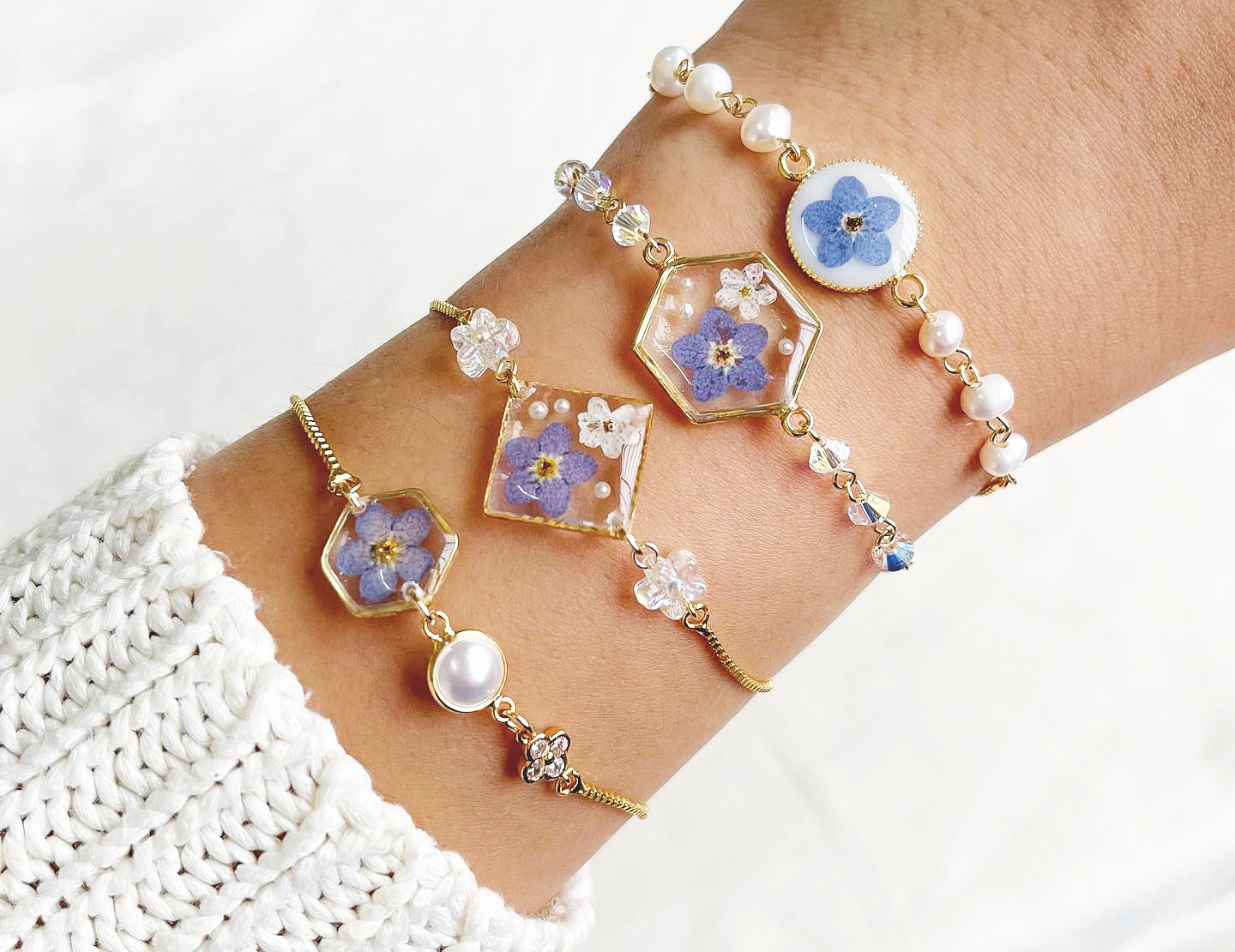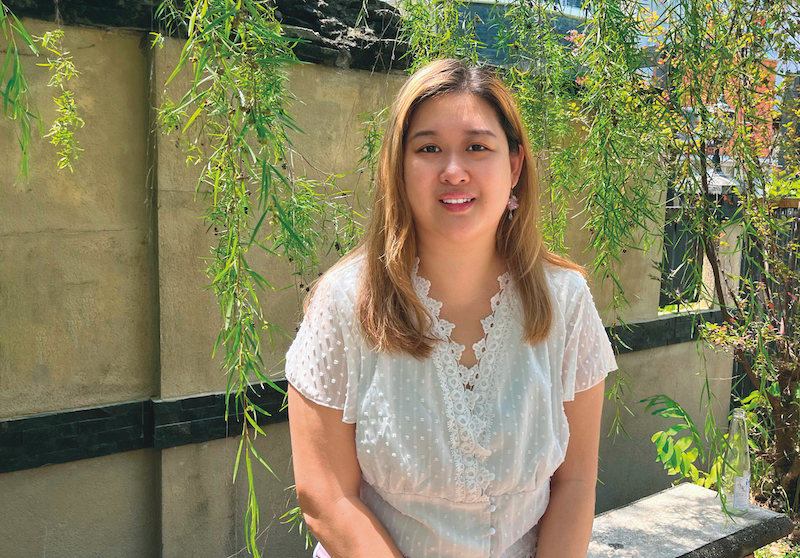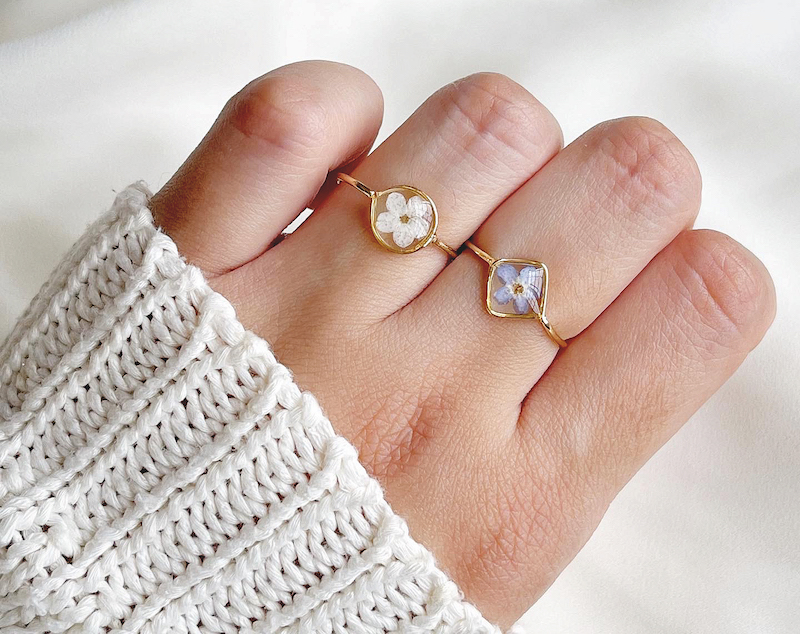
Yap tries to make jewellery patterns more appealing by mixing flowers with glitter, exploring different types of arrangements for the accessories to ensure each piece boasts a one-of-a-kind design (All photos: Beejooz)
The Malay proverb, Jauh perjalanan, luas pemandangan, which means “the farther you travel, the more knowledge you gain”, certainly rings true for Yap Sin Yi, who was inspired to take up a new hobby while on an overseas trip with a group of friends.
Yap, at the time, was looking to do something more meaningful apart from working nine to five as a graphic designer. A visit to Taiwan and Japan in 2016 gave her the opportunity to discover unique locally made jewellery.
“I saw many vendors selling these pretty accessories — I had never seen anything like that in Malaysia. I wanted to try making them because these items were sold at a very high price,” she says.
Upon her return, Yap researched resin accessories on Google, browsed Pinterest and watched YouTube videos. After an endless process of trial and error, she made a pair of earrings using resin and cherry blossoms — beautiful pink sakura that holds great significance in the country where she was first inspired to create jewellery.
She soon decided to showcase some of her products on Instagram to see whether she could turn her passion into profit. “I received good response from customers online before I started joining bazaars. At that time, I viewed the whole thing as a mere hobby as I was still working.”
After experimenting with the business model and seeing her venture grow, Yap noted its potential to be bigger. As such, she took a leap of faith and resigned from her job to establish Beejooz — a play on the word bijoux, French for “jewellery” — in 2017 and focus on it full time.
bj01.jpg

The 34-year-old’s first collection of cherry blossoms was a crowd favourite for the longest time. “I had to stop producing this design because it had been repeated several times. I wanted to offer my customers more options.”
From incorporating one flower to stacking the same kind of blossoms in an accessory, Yap has improved her offerings by using different types of florals to make them more attractive. She uses real pressed flowers sourced from China, such as white lace flower, forget-me-not, plum blossom, sweet alyssum, baby’s breath and daisy.
In the early days, she used to seek inspiration from Japanese makers who were experts in crafting resin jewellery.
“They had big flower collections and I loved looking at their designs. After some time, I realised I no longer needed to refer to anyone’s work to make my own pieces. The thought process flows naturally once you get your hands on the materials,” she says.
Making a single piece takes about half an hour: from choosing a frame, pouring the first layer of resin and arranging the blossoms, to pouring another layer of resin and removing the bubbles produced from the liquid.
The resin is housed in a variety of frames in shapes such as square, teardrop, rectangle, heart and star. Instead of plain skeletons, these structures are adorned with distinctive delicate details, giving each jewellery item special characteristics.
Yap tries to make the patterns more appealing by mixing flowers with glitter, exploring different types of arrangements for the accessories to ensure each piece boasts a one-of-a-kind design. As the items are unique, she passes on orders to make something that has been produced in the past. “But if customers ask for a certain colour combination, we will try to fulfil their request.”
She also cleverly attaches pearls, charms and beads to the chains, to come up with an assortment of earrings, bracelets, rings, necklaces and brooches. Upon request, she can convert pierced earrings into clip-ons. To ensure her products are safe for use over a long period, Yap opts for 18-carat gold-plated metals, as the material is rust-resistant and hypoallergenic.
eb59ce1a-452b-48f3-8dca-1752780eec33.jpg

When it comes to designing a new collection, Beejooz’s savvy founder also considers what customers want. “From my observation, young ladies like to wear pastel- and soft-coloured accessories that can easily match different outfits. In my previous collection, released in conjunction with Hari Raya and the spring season, I used only pink flowers for my jewellery and the feedback was really good.”
During the lockdowns, she launched one collection per month. Now, only one new series is produced every three months as Beejooz has been an active participant in pop-up events in the Klang Valley. Thus, her prime focus is making sure there will be enough supply for physical sales.
Coming from a graphic design background, Yap says marketing her business online is among the challenges she is still trying to tackle. “Promoting new products is quite hard because you need to regularly post on Instagram so people can remember your brand. For Beejooz, we rely a lot on — and customers also look forward to — pretty pictures. So, I learnt about photography and photo editing to make sure the product photos are nice.”
This business allows her to sustain her livelihood while being a mother to a four-year-old boy. It also sparks unexpected friendships with customers.
“I am always open to hearing their feedback as I like to know what they think about my products. We also talk about random topics sometimes.
I hope Beejooz can continue to colour people’s lives with pretty accessories and meaningful connections,” she says.
This article first appeared on June 19, 2023 in The Edge Malaysia.


